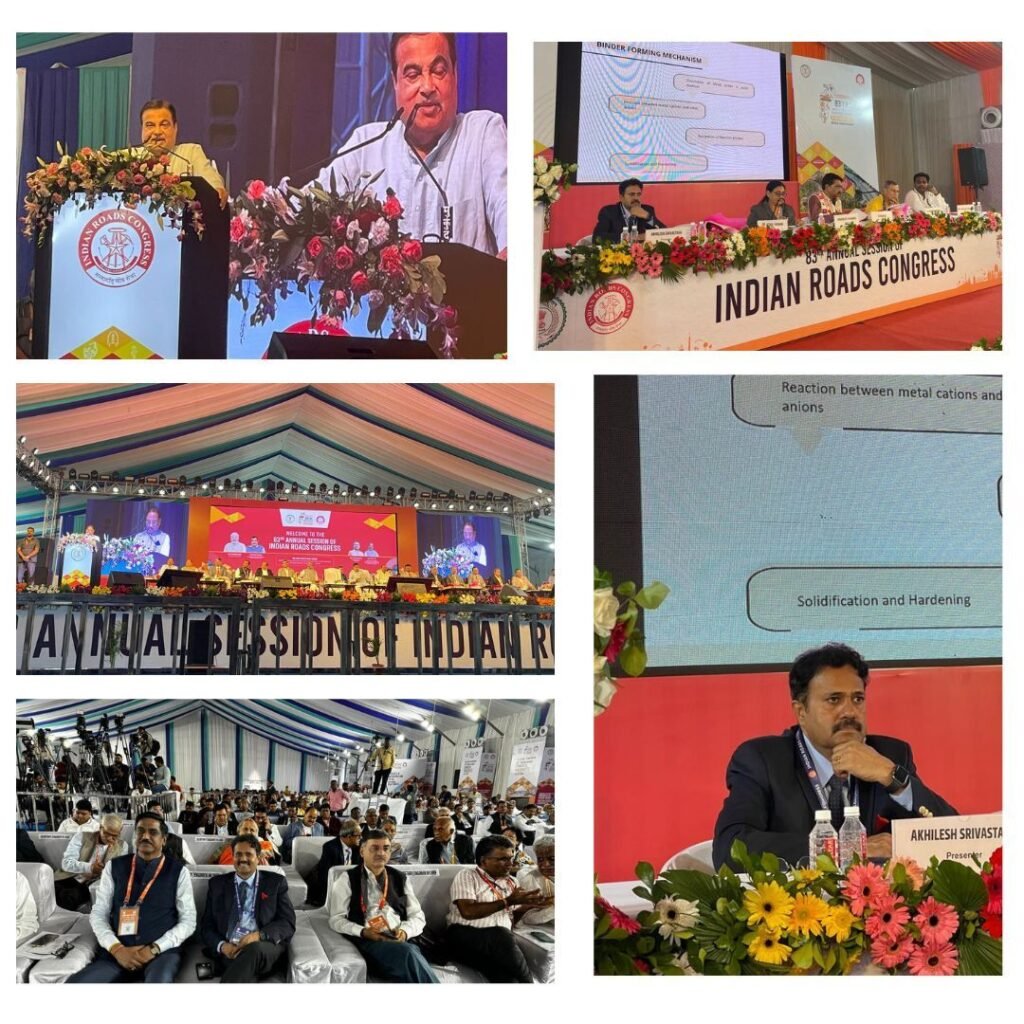Transforming India’s Road Infrastructure: Highlights from the 83rd Annual Session of the Indian Roads Congress

The 83rd Annual Session of the Indian Roads Congress (IRC) held in Raipur was a significant event dedicated to deliberating on the future of India’s road infrastructure. This gathering brought together policymakers, experts, and leaders from various sectors to envision a smarter, safer, and more efficient transport system for India. The event, guided by the vision of Honourable Road Transport and Highways Minister Shri Nitin Gadkari Ji, was supported by Honourable Minister of State MoRTH Shri Ajay Tamta Ji, the Chief Minister of Chhattisgarh, the Deputy Chief Minister, and other dedicated leaders. Together, they underscored a collective commitment to advancing India’s road infrastructure, aligning with the Vikshit Bharat Vision@2047.
Challenges in India’s Road Transportation Sector
India’s transportation sector is the backbone of the economy, yet it faces significant challenges. These include:
1. Increasing Road Accidents and Fatalities
India reports one of the highest numbers of road traffic accidents globally, resulting in thousands of fatalities annually. The alarming rate of road accidents is a pressing concern that necessitates immediate intervention and the implementation of safety measures.
2. Traffic Congestion
The rapid urbanization and growing number of vehicles on the road have led to severe traffic congestion in major cities. This not only increases travel time but also leads to economic losses due to wasted fuel and decreased productivity.
3. Environmental Impact
The rise in vehicular emissions has a substantial impact on the environment, contributing to air pollution and climate change. The need for eco-friendly solutions is more critical than ever.
4. Infrastructure Limitations
Despite significant investments in infrastructure development, gaps remain in terms of quality and connectivity. Poor road conditions, outdated designs, and lack of smart infrastructure hinder the efficient movement of goods and people.
5. Higher Logistics Cost
India’s logistics cost is among the highest in the world, accounting for about 14% of GDP. This not only affects the competitiveness of Indian goods but also places a financial burden on consumers.
The Role of Intelligent Transportation Systems (ITS)
To address these pressing issues, Intelligent Transportation Systems (ITS) offer an integrated approach that combines Human (driver), Infrastructure, and Vehicle technologies. ITS is at the heart of modernizing India’s transportation, leveraging advanced technologies to create a sustainable, efficient, and safer road network.
Key Technologies in ITS
1. Vehicle-to-Everything (V2X) Communication
V2X communication allows vehicles to communicate with each other (V2V), with infrastructure (V2I), and with other road users (V2P). This real-time data exchange helps in preventing accidents, reducing congestion, and enhancing traffic flow.
2. Advanced Driver Assistance Systems (ADAS)
ADAS uses sensors, cameras, and artificial intelligence to assist drivers in making safer decisions. Features like lane departure warnings, automatic emergency braking, and adaptive cruise control enhance driver safety and reduce the likelihood of accidents.
3. Internet of Things (IoT) in ITS
The Internet of Things (IoT) connects vehicles, infrastructure, and devices, enabling the collection and analysis of vast amounts of data. This data helps in monitoring traffic conditions, optimizing traffic lights, and managing road maintenance.
4. GIS in ITS
Geographic Information Systems (GIS) play a crucial role in ITS by providing real-time mapping and navigation services. GIS data helps in route optimization, traffic management, and planning of new infrastructure projects.
5. Telematics and Edge Computing
Telematics involves the use of telecommunications and informatics to send, receive, and store information about vehicles and their operation. When combined with Edge Computing, it allows for real-time processing of data at the source, reducing latency and enabling quicker decision-making.
6. Artificial Intelligence (AI) in ITS
AI in ITS is transforming traffic management and road safety. Machine learning algorithms analyze traffic patterns, predict congestion, and optimize traffic flow. AI also plays a pivotal role in autonomous driving technologies, which are expected to revolutionize the future of transportation.
Towards a Sustainable, Safe, and Efficient Transport System
The objective of these emerging technologies is to create a transport system in India that aligns with the Vikshit Bharat Vision@2047. The vision is to ensure:
- Commuter Safety: By leveraging technologies like V2X and ADAS, we aim to significantly reduce road accidents and fatalities.
- Affordability: Implementing smart infrastructure solutions will help reduce logistics costs, making transportation more affordable for businesses and individuals.
- Convenience: Real-time traffic monitoring and data analysis will lead to reduced congestion and shorter travel times, enhancing the overall commuting experience.
- Inclusivity: The integration of various modes of transport, including public transit, cycling, and walking, ensures that the transportation system is accessible and inclusive for all.
Potential Benefits of Intelligent Transportation Systems
Intelligent Transportation Systems have the potential to revolutionize India’s road network by:
1. Monitoring Traffic in Real-Time
With IoT sensors and AI algorithms, ITS can provide real-time updates on traffic conditions. This information helps in predicting congestion, optimizing traffic signals, and providing drivers with alternative routes.
2. Reducing Congestion
Traffic congestion is a major issue in urban areas. ITS can dynamically adjust traffic lights based on real-time data, manage traffic flow during peak hours, and reduce bottlenecks.
3. Preventing Accidents
By utilizing technologies like ADAS and V2X communication, ITS can alert drivers about potential hazards, helping to prevent accidents before they occur. Real-time data analysis can also identify high-risk areas, allowing authorities to implement targeted safety measures.
4. Enhancing Road Maintenance
IoT-enabled sensors embedded in road infrastructure can detect damage or wear and tear. This allows for predictive maintenance, reducing the likelihood of accidents caused by poor road conditions and extending the lifespan of infrastructure.
5. Lowering Logistics Costs
Efficient traffic management and optimized routes reduce fuel consumption and travel time, significantly lowering logistics costs. This enhances the competitiveness of Indian businesses and contributes to economic growth.
Implementing ITS for a Better Future
The discussions at the 83rd Annual Session of the Indian Roads Congress emphasized that the implementation of ITS is not merely a theoretical concept but a practical step towards shaping a modern transport system. The aim is to enhance the quality of life for commuters and ensure the sustainable growth of the nation.
The adoption of ITS is aligned with the Vikshit Bharat Vision@2047, which envisions a developed India with world-class infrastructure. By embracing innovative technologies and fostering collaboration between public and private sectors, we can build a transportation system that meets the demands of the 21st century.
The Road Ahead
The journey towards smarter roads is a collective effort that requires the collaboration of policymakers, industry experts, and the public. As we look ahead, the following steps are essential:
- Policy and Regulation: The government needs to establish clear policies and regulations that support the integration of ITS technologies into the existing infrastructure.
- Public-Private Partnerships (PPP): Collaboration between the public and private sectors will be crucial in developing and implementing ITS solutions.
- Investment in R&D: Continued investment in research and development will drive innovation in the field of intelligent transportation, ensuring that India stays ahead of the curve.
- Awareness and Education: Raising awareness about the benefits of ITS among the public and educating drivers on the use of advanced systems is key to successful implementation.
Conclusion
The 83rd Annual Session of the Indian Roads Congress in Raipur was a pivotal event that set the stage for transforming India’s road infrastructure. With a clear vision and a commitment to leveraging advanced technologies, India is poised to create a transportation system that is safe, efficient, and sustainable.
Intelligent Transportation Systems (ITS) will play a central role in this transformation, addressing critical issues like road safety, congestion, and environmental impact. As we move forward, it is imperative to continue these discussions and take concrete steps to realize the vision of a Vikshit Bharat by 2047.
Stay tuned as we implement these strategies and witness the evolution of India’s roadways into a world-class transportation network that benefits all citizens.
Contact Akhilesh Srivastava to learn more about these initiatives and be part of the journey towards a smarter, safer, and more efficient transport system in India.



